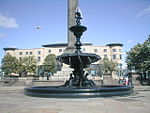William Brown Street
England road stubsStreets in LiverpoolUse British English from July 2017

William Brown Street in Liverpool, England, is a road that is remarkable for its concentration of public buildings. It is sometimes referred to as the "Cultural Quarter". Originally known as Shaw's Brow, a coaching road east from the city, it is named after William Brown, a local MP and philanthropist, who in 1860 donated land in the area for the building of a library and museum. This area gives its name as the William Brown Street conservation area.
Excerpt from the Wikipedia article William Brown Street (License: CC BY-SA 3.0, Authors, Images).William Brown Street
Cuerden Street, Liverpool Vauxhall
Geographical coordinates (GPS) Address Nearby Places Show on map
Geographical coordinates (GPS)
| Latitude | Longitude |
|---|---|
| N 53.41 ° | E -2.98 ° |
Address
Art Gallery Cafe
Cuerden Street
L3 8EL Liverpool, Vauxhall
England, United Kingdom
Open on Google Maps







